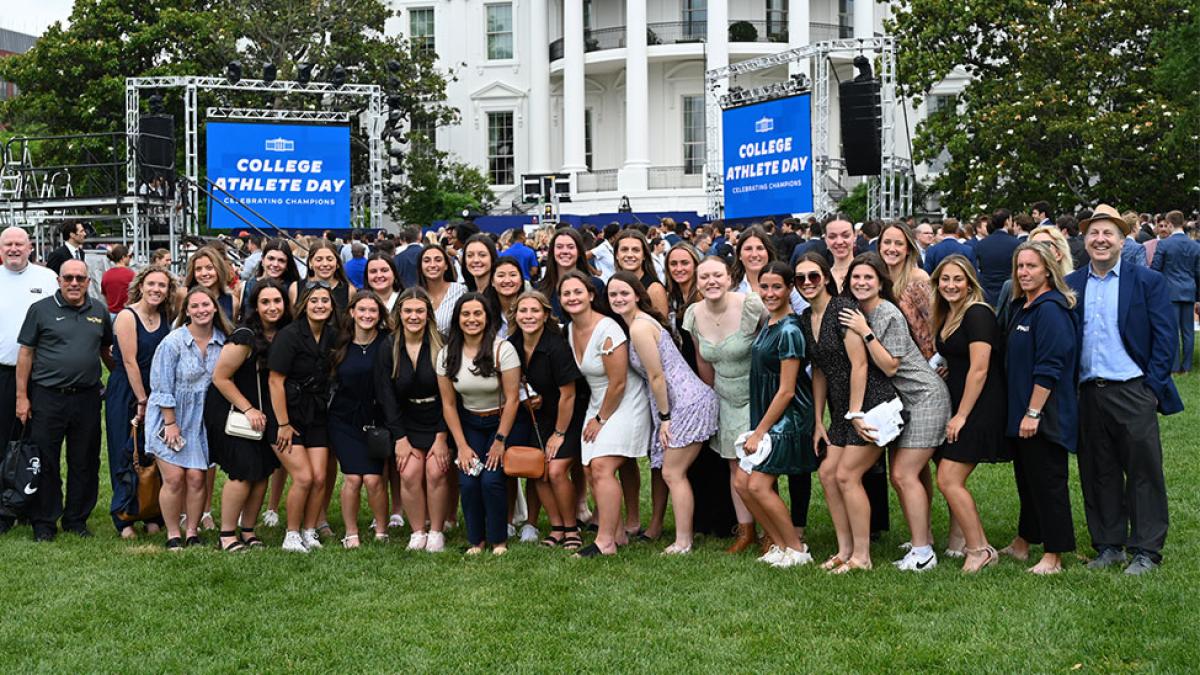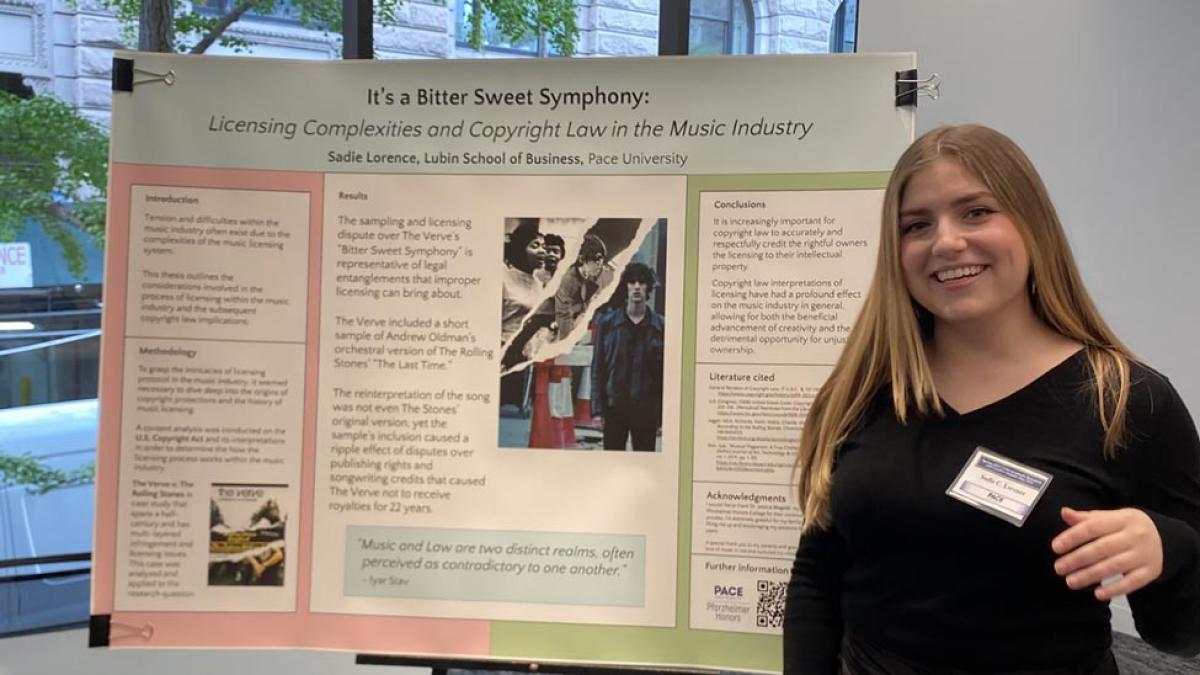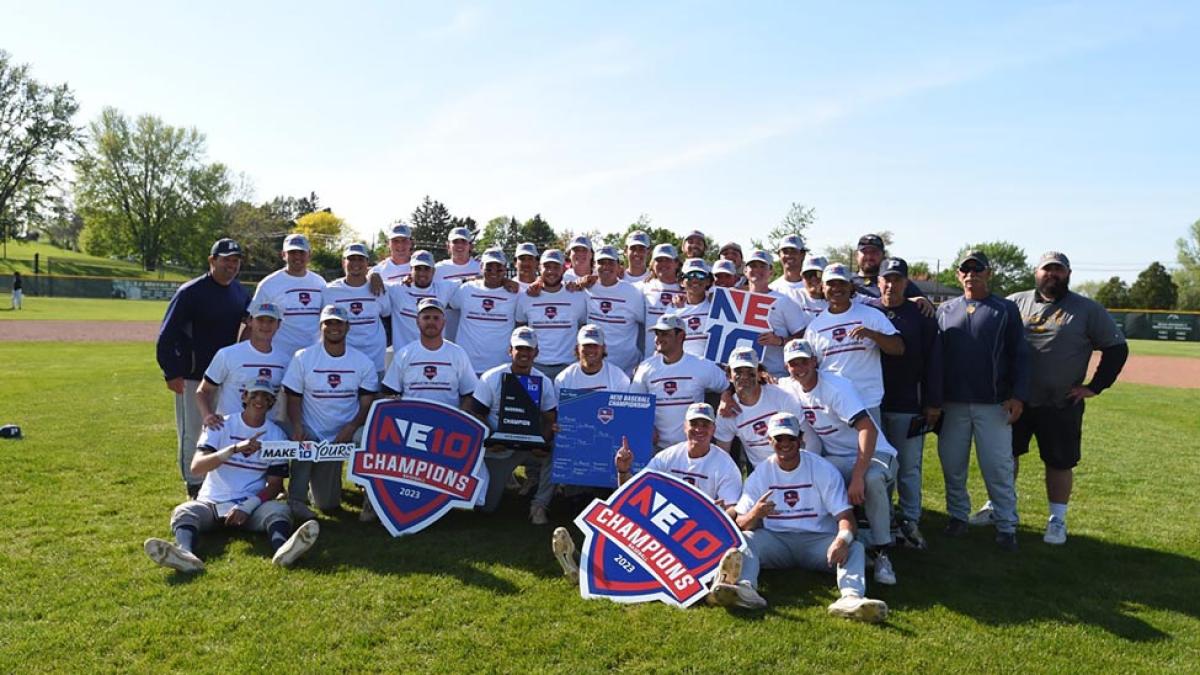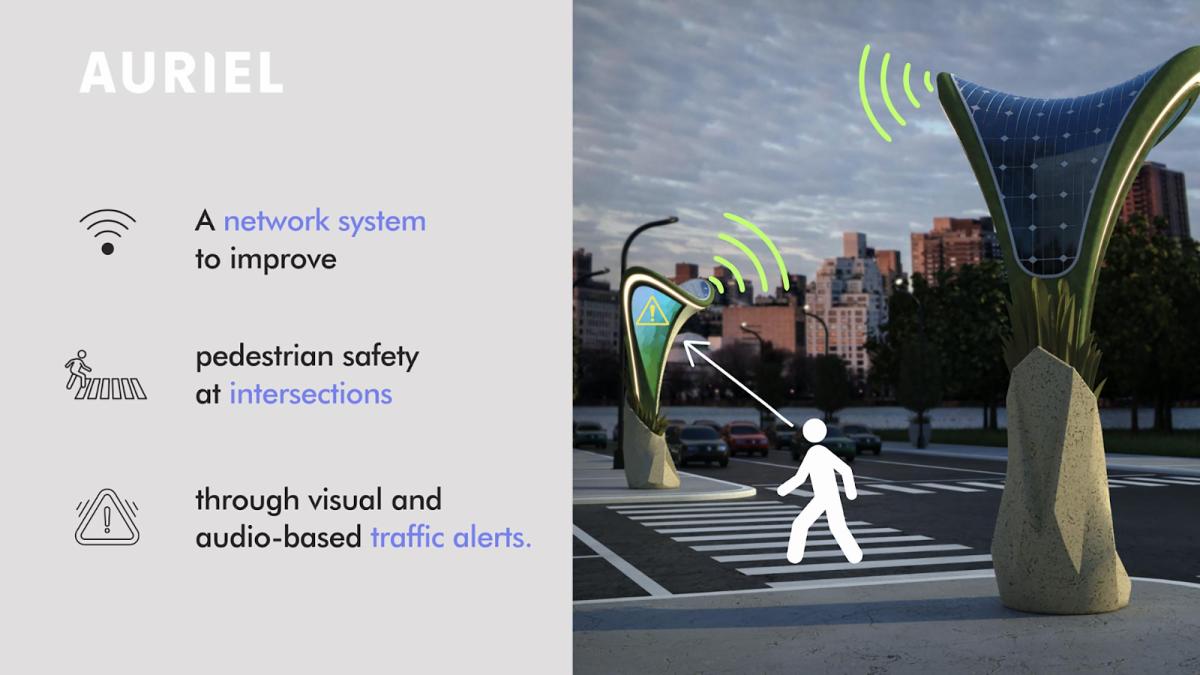
Designing the Future of New York City Streets
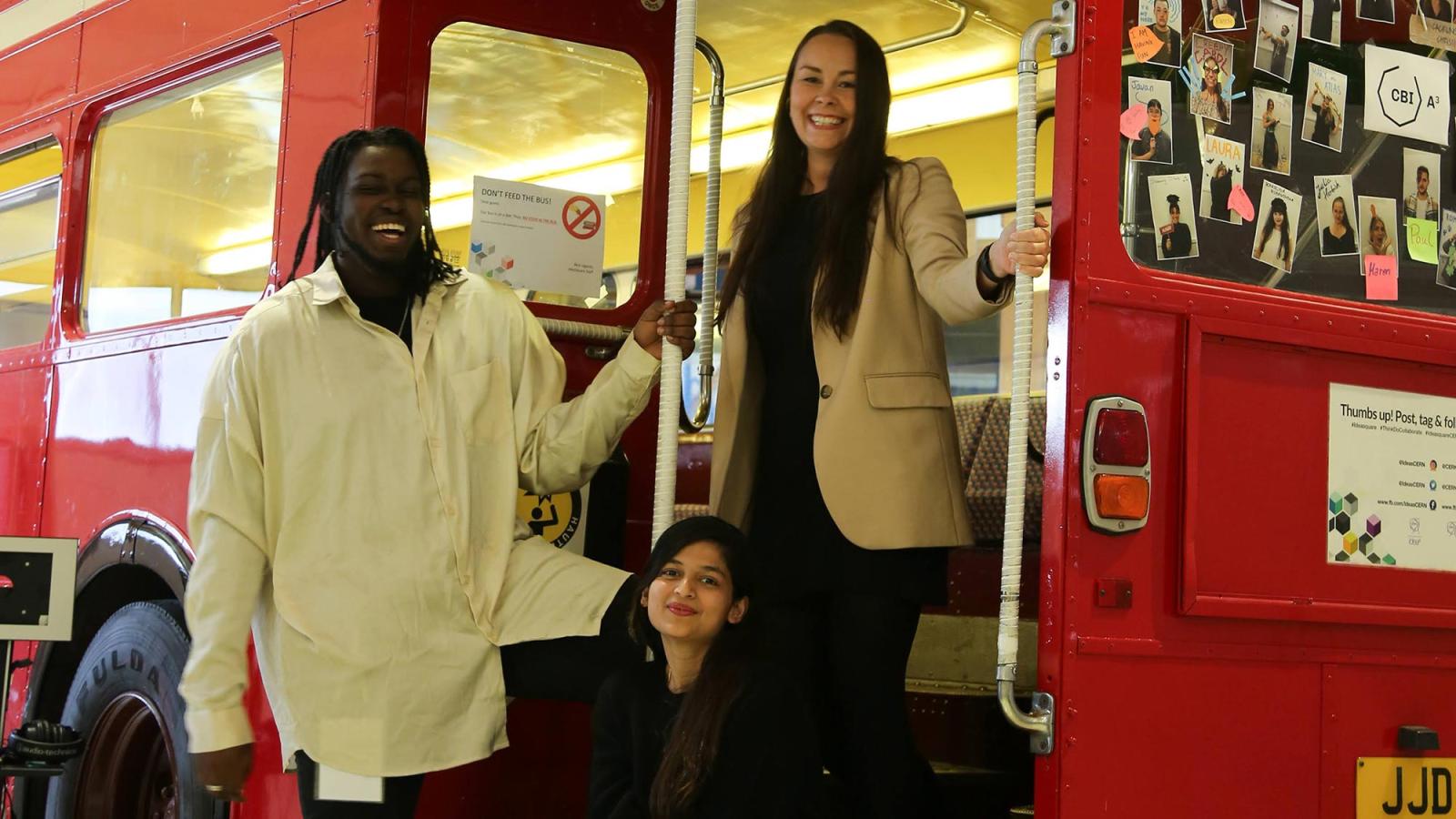
Imagine a traffic intersection two decades from now. What might it look like? How might pedestrians, automobiles, bikes, and new technologies interact with each other? How can the intersection of the future be maximized to protect the safety of human beings?
This was the task that Seidenberg graduate students Susanna Lammervo ’23, Aastha Bhadani ’23, and undergraduate student Sachin Archer ’25 enthusiastically tackled via an ambitious initiative from the Design Factory Global Network. The New York City Design Factory housed at Pace University is part of a network of 37 innovation hubs across 25 countries, dedicated to creating change in the world of learning and research through global and multidisciplinary collaboration. Through Pace’s NYC Design Factory, Pace students are privy to cutting-edge initiatives and projects that enable students to collaborate within this robust global network–and sometimes even travel the world.
For this particular project, Pace’s team participated in the Design Factory’s Challenge Based Innovation A³ project: an initiative focused on developing innovative outcomes from CERN, the European Organization for Nuclear Research and ATTRACT technology, a project funded by the European Union to explore problem areas framed by the United Nations’s Sustainable Development goal three, focusing on good health and well-being. Pace’s team, dubbed “Team Fusion'' embarked on a seven-month research and development journey, which included a team trip to CERN in Geneva, Switzerland, during which they learned how to tackle complex problems in a way that leads to innovative solutions. Their work was also presented by Susanna as part of the ATTRACT Academy Student Showcase in Bologna, Italy in June.
“You’re not just building with technology, you’re building with systems thinking, behavior change and future forecasting, trying to imagine how the world will look in 2040 or 2050. In the context of the curriculum,I find this exercise to be unique to this particular learning experience,” noted Seidenberg Clinical Professor and NYC Design Factory Director Andreea Cotoranu, who alongside Dyson Film and Screen Studies Chair Luke Cantarella served as the faculty mentors for this interdisciplinary endeavor.
You’re not just building with technology, you’re building with systems thinking, behavior change and future forecasting, trying to imagine how the world will look in 2040 or 2050.
Pedestrian safety is among one of the most pressing problems facing New York City today. In 2021, 273 people died in road traffic accidents in New York City, 50% of which were pedestrians. If you find yourself at any intersection in the city, you’ll likely see a cacophonous symphony of cars, bikes, e-bikes, buses, and pedestrians, some of whom might have their situational awareness compromised by the pull of a smartphone.
“NYC can have an individuality complex–everyone is out there for themselves,” said Sachin. “I took some time to look at myself and how I interact at an intersection.”
Resolving to improve pedestrian safety, Team Fusion got to work. Their goal? To employ a design-centered approach for improving pedestrian safety at New York City intersections, while reducing human error and enhancing decision-making for pedestrians. A vehicle-to-network (V2N), vehicle-to-infrastructure (V2I), and vehicle-to-pedestrian (V2P) system called Auriel, a state-of-the-art solution that relies on object-based data and a number of advanced technologies to keep New York City’s intersections safe.

Auriel, as shown above, would be installed at intersection corners across the city. From its screen, four visual animations (combined with three audio alerts) would be displayed to express different traffic scenarios and hazards–informing the pedestrian as to whether or not it would be safe to cross the street. This concept, as the team explains, gives more autonomy to pedestrians, while creating a simple system dedicated to keeping everyone safe.
“A lot of our design solution was based on our observations as to how pedestrians function in New York City—which is quite different from most other cities,” said Aastha. “When we were designing Auriel, we wanted to shift that traffic signal mindset to something that makes the pedestrian have the decision-making power in their hands.”
Equipped with a LiDAR-based sensor system, LED screen system, solar power system, and a communication system, Auriel would measure the speed, distance, and velocity of approaching vehicles, and identify the level of activity from the density of objects in the area. It also would employ a high speed information system with integrated AI to provide up-to-date traffic analysis and management.
All of this to say that the design solutions were often complex, and required a lot of deep thinking, and problem-solving from the team.
“I am familiar with the design thinking and how the design process goes, but for me, the most unexpected thing was how much workload there was–in a good way. We dug into the smallest little details and then had to scale out and think about how it would work on a macro-level,” said Susanna. “Scaling from the smallest details to a global aspect was very inspiring. It's good practice to do that.”
For the problem-space exploration phase of the project, the team traveled to IdeaSquare CERN in Geneva, Switzerland. While at ideaSquare the team met and collaborated with other students from across the world , and proudly represented the NYC Design Factory and Pace on the global stage.
The two-week immersive experience at IdeaSquare CERN was amazing,” said Susanna. “I don’t think I've ever learned that much about anything in two weeks.”
Upon returning from Switzerland, the team continued to collaborate to create the final concept, and a white paper (a research-based report) that lays out Auriel, its technical details, and an implementation plan in exhaustive detail. Honing in on everything from how Auriel would positively impact climate-friendly initiatives, to future-forecasting how scenarios like carbon-taxation might impact street design, the paper was lauded extensively by the team’s two faculty advisors, who admired the team’s ability to rise to this ever-complex challenge.
I don’t think I've ever learned that much about anything in two weeks.
“I’m very proud of all the work that the team has done,” said Cantarella. “When you’re working on a project like this, we don’t know the answers to the test. We have some skills, some insight, but we’re really together as a team to pull this all together. To me, that's such a refreshing and rewarding way to teach and learn.”
“We also need to recognize the students for their ability to step out of their comfort zone, '' added Cotoranu. “They found themselves in high-pressure situations, rapidly learning new things within tight timeframes. Their journey was filled with significant discomfort. I believe it is this discomfort that lies at the core of their remarkable growth.”
For Aastha, Susanna, and Sachin, the experience not only furthered their professional and technical skills, but was also a once-in-a-lifetime opportunity which they’ll look back fondly upon for many years to come–at which point, they might also be looking to cross the street by way of an Auriel-esque infrastructure.
“I’m not going to lie, it’s the best thing I’ve ever done in my life,” said Sachin. “It really changed my perspective and opened my eyes to the fact that there’s more to the world than just North America. And the fact that I can represent Black men in the tech world, that was touching for me.”
“I’ve been involved with a few Design Factory projects, but this is the best one,” said Aastha. “It was the highlight of my Pace journey.”
About CBI A3
CBI A3 is a Design Factory Melbourne (DFM) initiative, developed for the Design Factory Global Network (DFGN), in conjunction with IdeaSquare, CERN. It builds on earlier Challenge Based Innovation (CBI) that focus on design innovation to propose solutions that connect CERN’s deep technology with societal needs. The United Nations Sustainable Development Goals provide the framework for the CBI A3program and guide user-cantered research and design to focus on areas of high sustainable impact. This year CBI A3 brings together teams from Swinburne Design Factory Melbourne (AUS), New York City Design Factory (USA), Inno.space - Design Factory Mannheim (DEU), Warsaw Design Factory (POL) and Pratt Institute (USA).
CBI A³ 2022-23 & 2023-24 editions include projects funded by ATTRACT Academy. ATTRACT has received funding from the European Union’s Horizon 2020 research and innovation programme under grant agreement No. 101004462
Teaser and Hero Photo Credit: Aaron Down, CBIA3
More from Pace Magazine
National Championship? Check. A trip to the White House? Check. Read all about Pace women’s lacrosse’s dream season.
Lubin student Sadie Lorence spent her senior year researching the intricacies of a notable legal dispute around the ’90s hit song, “Bittersweet Symphony”–and in doing so, has found her professional calling.
Pace’s baseball team ended the season on quite a high note, amassing some silverware alongside some impressive individual awards.
